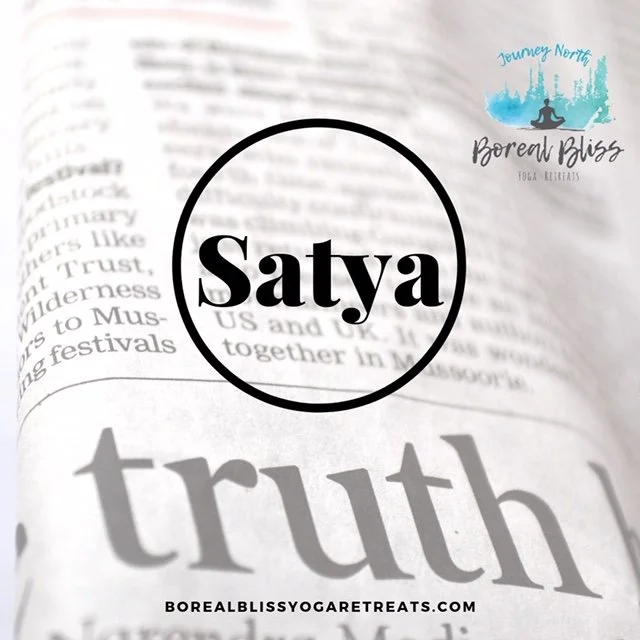Part 2 of 10: Satya (truthfulness)
Satya (truthfulness)
This post is the second in a ten-part series on the yamas (restraints) and niyamas (observances), yoga’s ethical guide to living. For some background, check out the first post, Ahimsa (non-violence). The first five elements of restraint outlined in the yamas, provide guidance for interacting with the physical or external world through non-violence (ahimsa), truthfulness (satya), non-stealing (asteya), non-excess (bramacharya), and non-possessiveness (aparigraha). If our life is full of complications due to our interactions with the world, it will be difficult to come to our yoga mat or meditation cushion. We must sort through the tangles in our external lives in order to untangle the turmoil within.
The second Yama (restraint) is satya or truthfulness.
When I first read Deborah Adele’s book, The Yamas & Niyamas: Exploring Yoga’s Ethical Practice (the inspiration for this blog series and a must-read), satya most struck me. I could see that while I was not lying in an overt way, my life was a compilation of little lies that, taken together, were degrading the quality of my life. I was attending events I didn’t have time to attend, agreeing to things I couldn’t afford, working long hours and prioritizing work above everything else, participating in traditions out of habit despite the way those traditions made me feel, and the list goes on. I did not have a clear sense of what I enjoyed or disliked because I had spent so much time trying to please others.
Before we dig in, we must establish that satya must always come from a place of ahimsa, non-harming. Satya encourages us to slow down, consider our choice to speak or not speak, and when we do speak, to speak in a way that is not damaging or violent to those around us. For example, while I have strong opinions and beliefs, it is not always appropriate to share those beliefs.
At the surface, truthfulness is the obvious choice. But, if you take a minute to reflect on lies you’ve told that still haunt you, I bet you will be able to come up with a few sources of shame. We often lie to ease the sting of the truth. I think there is a cosmic force at play that ensures that almost all lies end up biting the lie-teller in the keester. So why oh, why do we do it? And taking things a bit deeper, what are the actions we are taking that don’t feel true to who we are/want to be?
One: What does it mean to honor your truth rather than people pleasing?
As a Minnesotan, and as a woman, I was reeeeeally good at Minnesota Nice and people pleasing. I did not miss family events, showers, parties, or happy hours. If I was invited, I was going- with a relish tray. I wanted to be liked, so I avoided saying things that might elicit an undesirable response. For example, someone owed me money? “Nah, don’t worry about it!” If someone put me down (sometimes repeatedly and over many years), “Do I want to get together next Saturday? Definitely! What can I bring?!”
“Real asks us to live from a place where there is nothing to defend and nothing to manage. ”
A few years ago, my college roommate and a dear friend invited me to her 30th birthday party in Nashville. We couldn’t afford the trip at that time, and in an unprecedented move, I told her I couldn’t attend. I was beginning to step into truthfulness. However, I did not give her a reason. Instead, I ghosted her for months. After nearly a decade of laughing and talking with one another about everything and anything, I chose not to speak with her because it was easier to avoid a painful situation than face the truth.
After about a year of this, my friend confronted me and told me how hurt she was that I did not attend the party. I was honest. I told her that at the time, we couldn’t afford the trip because we were facing unexpected medical bills. I watched her face soften, and eyes widen, resentment melted into compassion and concern. She said, “I had no idea. I wish you would have told me.” My failure to be real with her caused us both a year of tension and anguish.
When I over-commit to things, as I often do after a lifetime of practice, I show up physically but not emotionally or mentally. I am learning that attending fewer events, but attending them wholeheartedly, is more meaningful for all parties involved. I can be fully present. I am rested and prepared for the event. I can show up with humor and enthusiasm vs. strained and tired.
This people pleasing business could be an entire book, and it probably is. But the gist is if you are doing something to make someone else happy that makes you feel yucky, it might be time to step into truthfulness. Here are a few examples:
Gifts. For some, gift giving is an expression of love. After decades of consumerism, many families are re-evaluating what is essential, experiences vs. gifts, wants vs. needs, and the role of material possessions in the house.
Traditions can, (and should!), evolve. If the conversations come from a place of respect rather than judgment, growth and understanding can follow. For example, my mom no longer wraps my presents with gift-wrapping paper. Instead, she uses paper bags and newspapers. This extra effort makes the gift even more meaningful. We’ve overhauled the gift giving experience in our family, and I expect the traditions to continue to change as we change.
The monetary expectations around gift-giving are also something that should be on the table for discussion. It is okay to say, “this year, we aren’t able to participate in gift exchanges, but we would love to get together for hot cocoa and sledding.”
These conversations are difficult. I have found that the discomfort is well worth the improved understanding of one another and creating new traditions, together.
Money. Being real with friends and family about money is a game-changer. Most people want to support you in financial goals. So when I tell friends, “my out-to-eat budget for the month is pretty low, can we do a picnic or a walk instead?”
I have found that friends are entirely receptive to this shift. It has created a respectful and positive awareness of monetary obligations. When one friend sets the boundary that their funds are finite, it permits the whole group to continue having a relationship based on free or inexpensive activities. We discuss budgeting and our financial goals, we have a support system to talk about financial issues rather than feelings of shame and secrecy.
Two: Apologies, Letting Go, and Integrating the Truth (even though it’s painful)
Facing our feelings of shame is one of the most challenging things we can do. It is much easier to make excuses, blame others, deny the reality, and ignore the past. Satya calls us to reflect on those uncomfortable moments from a place of non-violence. We can forgive our past self for the mistakes made. Owning these stories and viewing our narrative with compassion can help us move on from these great sources of shame. Satya calls us to stand in our truth, the good and the bad. Only by acknowledging the darkness can we move through and stand fully in the light.
It may be the case that we owe someone, somewhere, an apology. When I was in middle school, a friend gave me her grandmother’s clip-on earring collection after she passed. I was unappreciative and mocked some of the earrings. It still causes me physical discomfort to type this. I carried the shame from this incident for decades, even though we remained close friends throughout that time. In my study of satya, I decided enough was enough. I apologized, more than twenty years after the fact. I apologized for lacking grace and empathy during her time of pain.
I’m not recommending apologizing for every twenty-year-old transgression you are carrying around. I do believe in the power of apology and forgiveness. At one of our retreats, Sarah Seidelmann shared a shamanic ritual for letting things go, read her full description of the process here. Find a rock or stick and think of the memory that is weighing you down, the source of sadness you are working to let go (maybe forgiving yourself or forgiving someone else). Blow on the rock or stick three times with intention using an audible and forceful exhale. Then either burn or bury the stick, or throw the stone in a body of water and let it go. The NYT released this article on the science behind letting go of grudges just this morning!
This work cannot happen in a day. Facing the truth about ourselves is uncomfortable, hard work. Working toward a better version of self and cultivating inner peace is why we practice yoga, meditation, and pranayama- to prepare ourselves to face the harshness and joyousness of life from a place of awareness and calm. Integrating the past, forgiving ourselves, and moving forward is difficult work. I plan to keep at it for the rest of my life.
Three: Choosing Silence
“The compassion of non-violence keeps truthfulness from being a personal weapon. It asks us to think twice before we walk around mowing people down with our truth, and then wonder where everyone went.” -Deborah Adele, The Yamas & Niyamas
As a younger person, I have spent most of my life being vocal. I think quiet is a skill learned with age and practice. I am learning to cultivate quiet by seeking out intentional silence (literally spending hours without speaking, reading, or writing) and meditation. Intentional silence is like muscle memory; the more I practice, the easier it is to find the pause between speaking and not speaking. All I need is that microsecond of pause to respond in a nonviolent way (or not to respond at all).
Conversely, satya also encourages us to use our voice and speak truth when the timing is right!
“How much time do you spend having to find someone you were a little harsh with and apologize? Or go back and tell someone you can’t do what you said you would do? Or maybe you spend your time and energy trying to avoid that person because of your embarrassment. Can you imagine speaking and acting so correctly that you never have to go back and apologize or make a new agreement?”
Four: Being honest with yourself
Humans tend to think of the future self as a stranger. We are programmed to put our short-term needs in front of long-term needs, thanks brain! Scientific studies have shown that people who look at an aged photo of themselves do a better job saving for the future. Read more about this here.
For years, looking at bank statements felt like entering a haunted house. I forgot passwords, avoided bank statements, and generally avoided taking a hard look at where my money was going. I was dishonest with myself about my financial well-being. I didn’t want to know how much I spent on groceries or dining out because not knowing was much more comfortable (ignorance is bliss!).
Again, when I finally decided to “get real” with my finances, I was surprised by the feelings of confidence and calm that followed. By simply looking into my finances, facing them with non-judgment and acceptance, I was able to overcome the fear.
The same is true of other scary truths listed above, like aging and death. Last year I read two books that blew my mind on the topic. Smoke Gets in Your Eyes by Caitlyn Doughty and When Breath Becomes Air by Paul Kalanithi. Satya invites us to live our lives so well, so present in our relationships, that we do not fear the inevitability of death.
Satya encourages us to avoid putting off things for the future. After helping my Grandma put together stories from her life for years, studying satya encouraged me to finally take the time to put the stories together and print copies for the family. The experience was beautiful. Take the time to make that photo calendar or album you’ve been putting off. Rip off the bandaid and spend an hour or two to make the album. It will feel great when it’s done and it’s okay if the product is imperfect!
We gotta look out for our future self. (-: Future Amanda has important things to do like wear a fanny pack in retirement and dress like Miss Frizz and grow up to look exactly like my Mom and Grandma. I want to be nice to her. Past Amanda has made some… awesome decisions about money (cough). But that’s okay, 32-year-old Amanda is not mad at Past Amanda.
Whatever the truth is, facing your fear with non-judgment and acceptance may help take the power away from the fear itself. Say your truth out loud. You can do this and know that you are not alone. Seek support from friends, family, and/or professionals to help you work through issues you cannot tackle alone.
Five: Gossip, work on it.
“We are addicted to our pet hatreds. We don’t quite know what we would do without the people we dislike. We meditate on their bad qualities, and they become our alter egos- everything that we are not. We define ourselves in this way. When we say something unpleasant about somebody, we can get a buzz of pleasure, rather like the first drink of the evening. So we must wean ourselves from our addictions, our pet grudges, annoyances, and hatreds- but it’s a project for a lifetime.” –Karen Armstrong
Recently I’ve been working on putting up a mental stop sign when I hear myself wanting to say, “Don’t tell anyone this but…” or “this is between us…”
Like Karen says, it’s a project for a lifetime.
The Magic of Satya
When we commit to honoring the truth in all forms, with ourselves and with others, things seem to fall into order, and life becomes less complicated. The busyness slows down. Time begins to bloom, and opportunities for leisure time and contentment are available in places we least expect them. When we quiet the drama of WORK! STRESS! DRAMA! FAMILY FEUDS! GOSSIP! We find the freedom to pursue the life work that calls to us with intention. We step into our role as mother, daughter, friend, activist, creator, manager, mathematician, politician, nurse, teacher, with focus, intention, compassion, and drive.
“Living the life that cries to be lived from the depth of our being frees up our energy and vitality. The juices flow. Everyone around us benefits from the aliveness that we feel. On the other hand, suppressing that life, for whatever reason, takes a lot of our life energy just in the managing of the pretending.”
Journal Prompts:
Did anything in this blog resonate with you or make you a bit uncomfortable? If yes, take a moment to write about it. Acknowledge the discomfort.
Think of a past situation that is an ongoing source of shame or discomfort. Write a compassionate letter of forgiveness to yourself for that situation.
Write “truthfulness” on a piece of paper and hang it up somewhere you will see it daily. Spend a month sitting with this concept.
Write about, or meditate on, the following: How do I know what is genuinely me if I’ve been going with the crowd and seeking social acceptance my whole life?
Resources:
The Yamas & Niyamas, Exploring Yoga’s Ethical Practice by Deborah Adele
The Eight Limbs of Yoga, A Handbook For Living Yoga Philosophy by Stuart Ray Sarbacker and Kevin Kimple
Smoke Gets in Your Eyes by Caitlyn Doughty
When Breath Becomes Air by Paul Kalanithi
The Heart of Yoga by T.K.V.Desikachar
YOU MAY ALSO BE INTERESTED IN:
Part 1 of 10: Ahimsa (non-violence)
How to Use the Breath to Release Unwanted Emotions
All Natural Spring Cleaning
Setting a Sankalpa
When Change is Brewing on the Horizon



